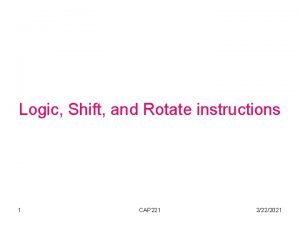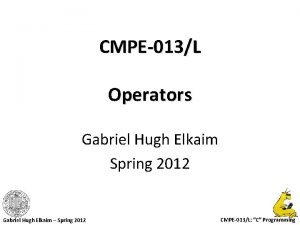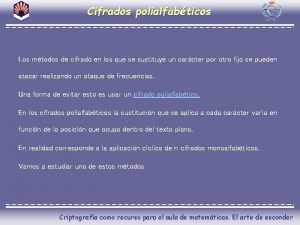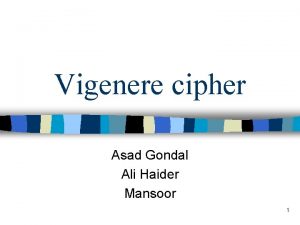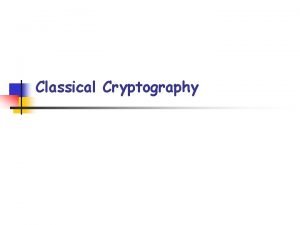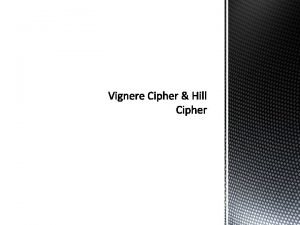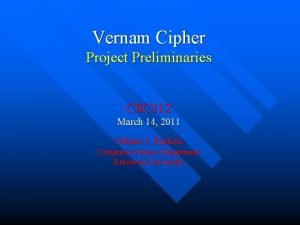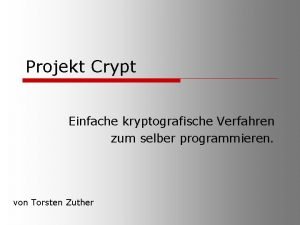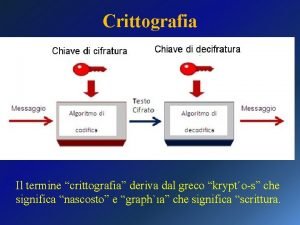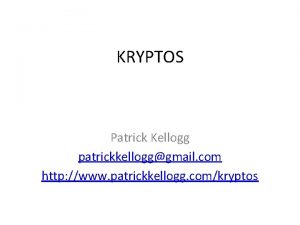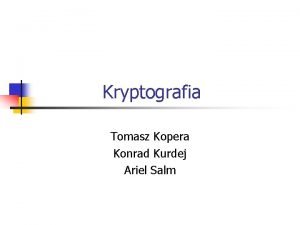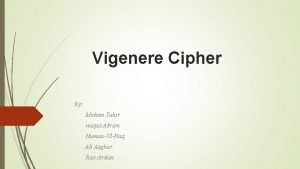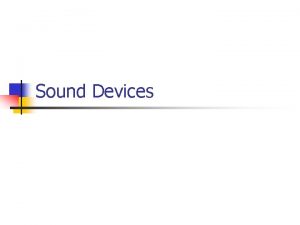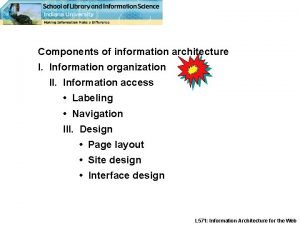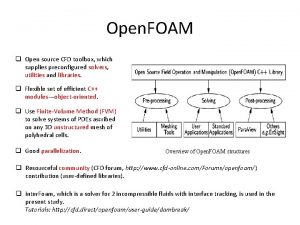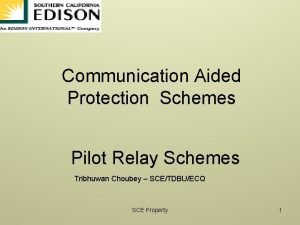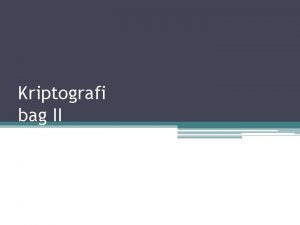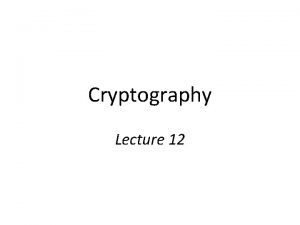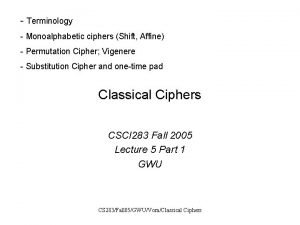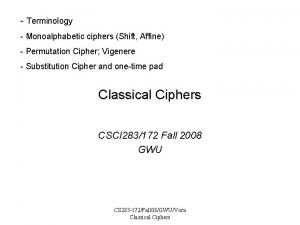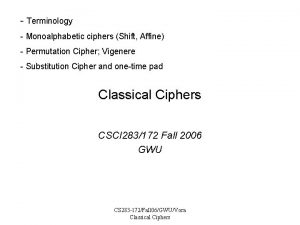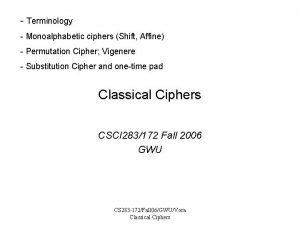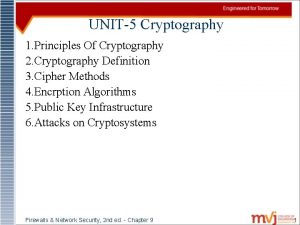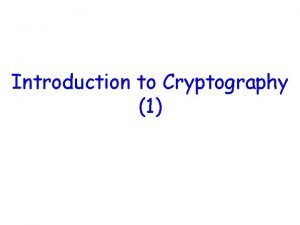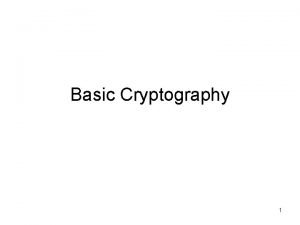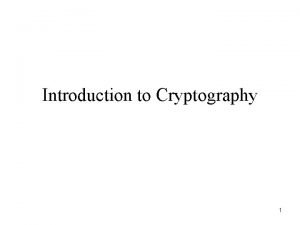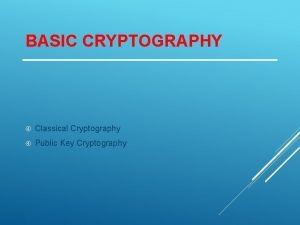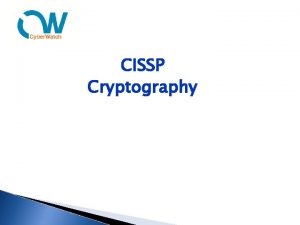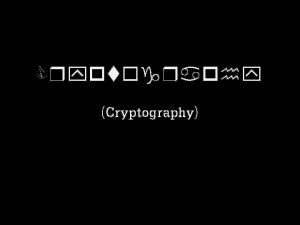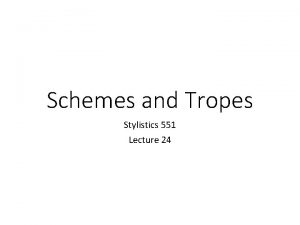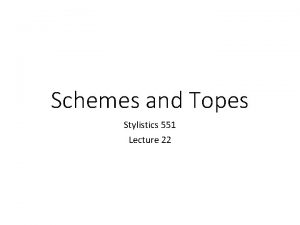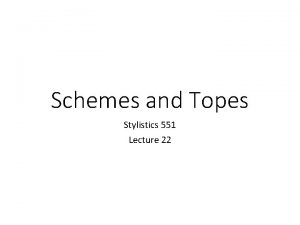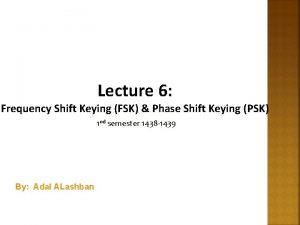Cryptography Lecture 11 Historical schemes Shift Vigenere etc
































- Slides: 32

Cryptography Lecture 11

Historical schemes • Shift, Vigenere, etc. – They are all easy to attack – They are not used anymore • The point of this material was to motivate the need for a more formal treatment

Perfect secrecy • A more formal approach – Definitions – Proofs • Definition of perfect secrecy • The one-time pad achieves this definition • Several inherent drawbacks of perfect secrecy – The one-time pad is not used

Private-key encryption • If we want to overcome drawbacks of perfect secrecy, we must relax the definition – Computational secrecy • EAV-security – (Computational) secrecy for encryption of one message • We now need to rely on assumptions in order to prove security

Private-key encryption • Pseudorandom generators/stream ciphers – Formal definition – For now, we simply assume these exist • Pseudo-one-time pad – (Provable) EAV-security based on any PRG – Message length longer than key length – Not secure when multiple messages encrypted, or against chosen-plaintext attacks

Private-key encryption • CPA-security – Security against chosen-plaintext attacks – Requires randomized encryption! • Pseudorandom functions/block ciphers – Formal definition – For now, we simply assume these exist (e. g. , AES) • Basic encryption scheme – (Provable) CPA-security based on any PRF – 2 x ciphertext expansion

Private-key encryption • Modes of encryption – CBC-mode, CTR-mode are both CPA-secure, and have ciphertext expansion of one block – Stream-cipher modes – These are used extensively in the real world • CCA-security – Security against chosen-ciphertext attacks – This is a real-world problem (cf. many attacks possible) – None of the schemes we have seen so far satisfy this notion of security

Message authentication codes • Integrity as an orthogonal security concern – Secrecy and integrity are different – Encryption and message authentication are different • Message authentication codes, and definition of security • Basic MAC from any PRF – Short, fixed-length messages only

Message authentication codes • Constructing a MAC on longer messages? – Different attacks to watch out for • (Basic) CBC-MAC – Secure for fixed-length messages • CBC-MAC – Secure for arbitrary-length messages – Used in the real world

Authenticated encryption • Communication with secrecy and integrity • An AE scheme is an encryption scheme that achieves both – CCA-security – Unforgeability • Encrypt and authenticate is not a sound generic construction

Authenticated encryption

Secrecy + integrity? • We have shown primitives for achieving secrecy and integrity in the private-key setting • What if we want to achieve both?

Authenticated encryption • An encryption scheme that achieves both secrecy and integrity • Secrecy notion: CCA-security • Integrity notion: unforgeability – Adversary cannot generate ciphertext that decrypts to a previously unencrypted message

Generic constructions • Generically combine an encryption scheme and a MAC – Useful when these are already available in some library • Goal: the combination should be an authenticated encryption scheme when instantiated with any CPA-secure encryption scheme and any secure MAC

Generic constructions? • Encrypt and authenticate • Authenticate then encrypt • Encrypt then authenticate

Encrypt and authenticate c, t k 1, k 2 m c Enck 1(m) t = Mack 2(m) k 1, k 2 m = Deck 1(c) Vrfyk 2(m, t) = 1?

Problems • The tag t might leak information about m! – Nothing in the definition of security for a MAC implies that it hides information about m – So the combination may not even be EAV-secure • If the MAC is deterministic (as is CBC-MAC), then the tag leaks whether the same message is encrypted twice – I. e. , the combination will not be CPA-secure

Authenticate then encrypt c k 1, k 2 m t = Mack 2(m) c Enck 1(m | t) k 1, k 2 m | t = Deck 1(c) Vrfyk 2(m, t) = 1?

Problems • Counterexamples are possible • The combination may not be CCA-secure

Encrypt then authenticate c, t k 1, k 2 m c Enck 1(m) t = Mack 2(c) k 1, k 2 Vrfyk 2(c, t) = 1? m = Deck 1(c)

Security? • If the encryption scheme is CPA-secure and the MAC is secure (with unique tags) then this is an authenticated encryption scheme • It achieves something even stronger: – Given ciphertexts corresponding to (chosen) plaintexts m 1, …, mk, it is infeasible for an attacker to generate any new, valid ciphertext!

Authenticated encryption • Encrypt-then-authenticate (with independent keys) is the recommended generic approach for constructing authenticated encryption • In fact, academia tend to use a stronger integrity notion --- integrity of ciphertext • Adversary cannot forge a new ciphertext • (Not required in this course)

Direct constructions • Other, more-efficient constructions have been proposed and are an active area of research and standardization • E. g. , OCB, CCM, GCM, SIV • Others… – Active competition: https: //competitions. cr. yp. to/caesar. html

Secure sessions

Secure sessions? • Consider parties who wish to communicate securely over the course of a session – “Securely” = secrecy and integrity – “Session” = period of time over which the parties are willing to maintain state • Can use authenticated encryption…

Enck(m 1) Enck(m 2) k Enck(m 3) k

Replay attack Enck(m 1) Enck(m 2) k Enck(m 1) k

Re-ordering attack k Enck(m 1) Enck(m 2) Enck(m 1) k

Reflection attack Enck(m 1) Enck(m 2) k

Secure sessions • These attacks (and others) can be prevented using counters/sequence numbers and identifiers

Enck(“Bob”| m 1 | 1) Enck(“Bob” | m 2 | 2) k Enck(“Alice” | m 3 | 1) k

Secure sessions • These attacks (and others) can be prevented using counters and identifiers – Can also use a directionality bit in place of identifiers
 Blaise de vigenere cryptography
Blaise de vigenere cryptography Difference between arithmetic shift and logical shift
Difference between arithmetic shift and logical shift Posselt's envelope of motion
Posselt's envelope of motion Bathochromic shift and hypsochromic shift
Bathochromic shift and hypsochromic shift Logical shift and arithmetic shift
Logical shift and arithmetic shift Cap 221
Cap 221 Difference between arithmetic shift and logical shift
Difference between arithmetic shift and logical shift Bathochromic shift and hypsochromic shift
Bathochromic shift and hypsochromic shift Difference between arithmetic shift and logical shift
Difference between arithmetic shift and logical shift Homocyclic diene component
Homocyclic diene component Szyfr vigenère kalkulator
Szyfr vigenère kalkulator Cifrado vigenere en java
Cifrado vigenere en java Cryptosystem
Cryptosystem Kasisky test
Kasisky test Vigenre
Vigenre Vigenere definition
Vigenere definition Tabel vigenere cipher
Tabel vigenere cipher Des round structure
Des round structure Cipher yang termasuk ke dalam cipher abjad-majemuk adalah
Cipher yang termasuk ke dalam cipher abjad-majemuk adalah Vernam cipher example
Vernam cipher example Verschlüsselung
Verschlüsselung Codice monoalfabetico
Codice monoalfabetico Kryptos k4
Kryptos k4 Algorytm vigenere
Algorytm vigenere Vigenere cipher
Vigenere cipher 01:640:244 lecture notes - lecture 15: plat, idah, farad
01:640:244 lecture notes - lecture 15: plat, idah, farad Rap sentences that rhyme
Rap sentences that rhyme Components of information architecture
Components of information architecture Shield punt formation
Shield punt formation Free poem
Free poem Swak4foam
Swak4foam Pilot relaying schemes
Pilot relaying schemes Tricolon
Tricolon





